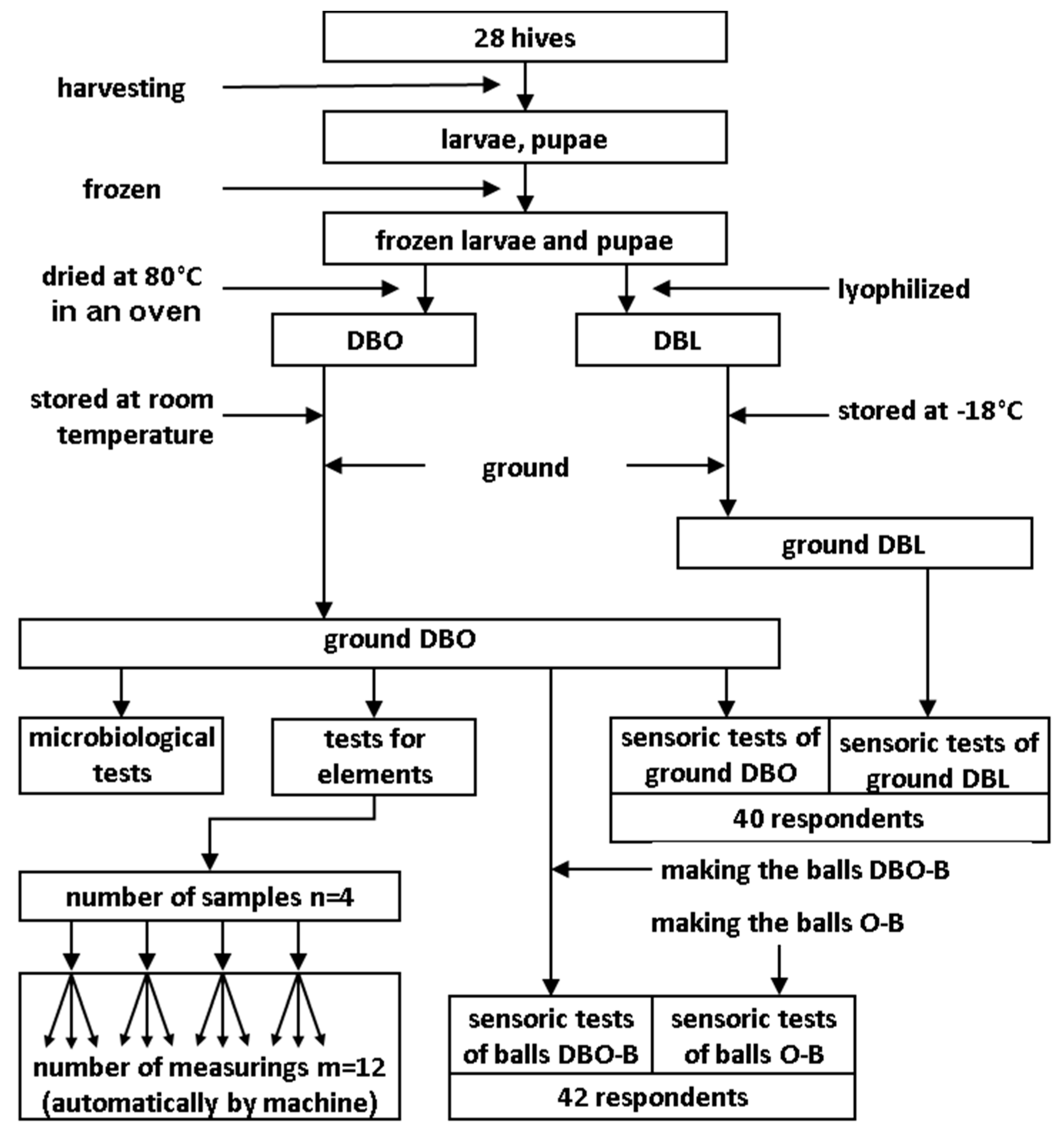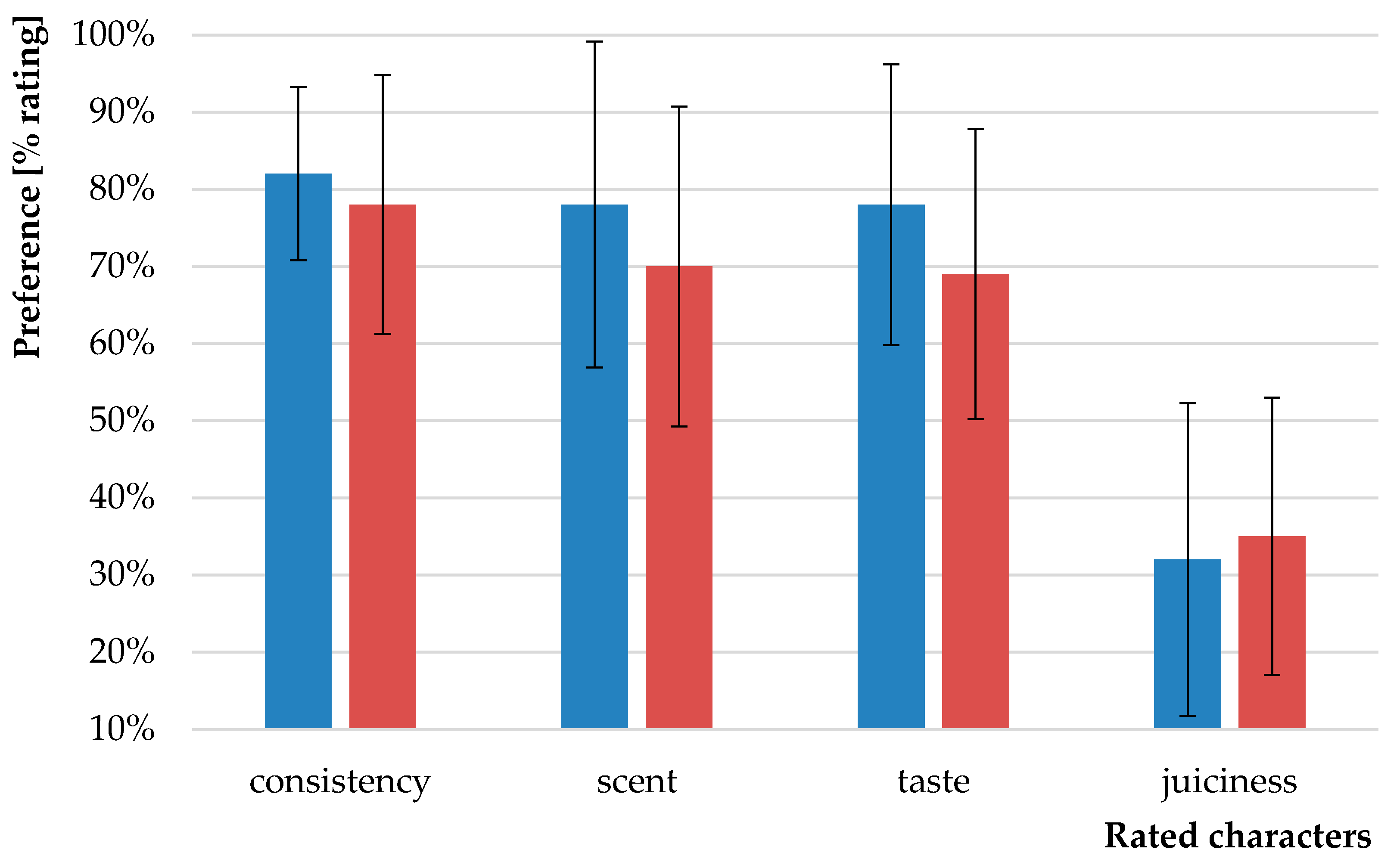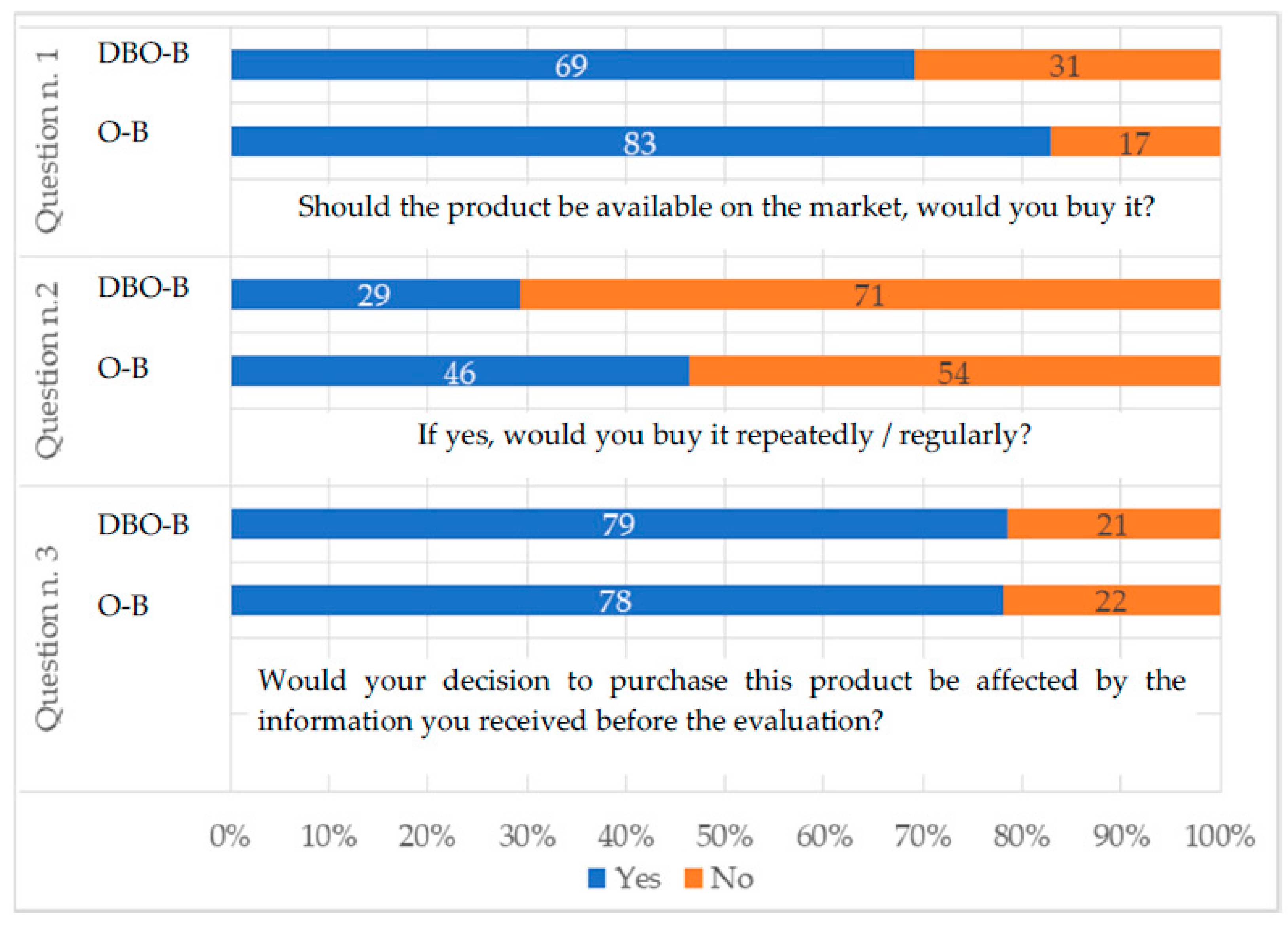Use of Foods Based on Bee Drone Brood: Their Sensory and Microbiological Evaluation and Mineral Composition
Abstract
:1. Introduction
- (a)
- Drone brood is safe from a microbial and elemental point of view for the production of DB-based foods (the measured values are below the safety limits);
- (b)
- In terms of sensory properties, DB-based products are acceptable to consumers.
2. Materials and Methods
2.1. Collection and Conservation of Bee Drone Brood
2.1.1. Drying
2.1.2. Lyophilization
2.2. Determination of the Elements
2.3. Microbial Analysis
2.4. Preparing the Balls
2.5. Sensory Analysis
2.5.1. Sensory Evaluation of the Dried Bee Drone Brood Sample
2.5.2. Sensory Evaluation of the Balls
2.6. Statistical Analysis
3. Results
3.1. Mineral Content
3.2. Microbiological Evaluation of the DBO Sample
3.3. Sensory Analysis Evaluation
3.3.1. Sensory Analysis of the Dried Bee Drone Brood Sample
3.3.2. Sensory Analysis of Balls
4. Discussion
4.1. Determination of Element Content
4.2. Microbiological Evaluation of the DBO Sample
4.3. Sensory Analysis Evaluation
4.3.1. Sensory Analysis of the Dried DBO Sample
4.3.2. Sensory Analysis of Balls
5. Conclusions
Author Contributions
Funding
Institutional Review Board Statement
Informed Consent Statement
Data Availability Statement
Conflicts of Interest
References
- Premalatha, M.; Abbasi, T.; Abbasi, T.; Abbasi, S.A. Energy-efficient food production to reduce global warming and ecodegradation: The use of edible insects. Renew. Sust. Energ. Rev. 2011, 15, 4357–4360. [Google Scholar] [CrossRef]
- FAO. Edible Insects: Future Prospects for Food and Feed Security; FAO: Rome, Italy, 2013; 187p, Available online: https://www.fao.org/3/i3253e/i3253e00.htm (accessed on 20 February 2022).
- Simakovič, N.N.; Belaruski, P. “Okřídlení farmaceuti” dávají mužům sílu (“Winged pharmacists” give men strength). Odborné Včelařské Překlady (Prof. Beekeep. Transl.) 2016, 2, 1–5. [Google Scholar]
- Kulhánek, Z. Tube milk-elixir for men. Vcelarstvi 2016, 7, 243. [Google Scholar]
- Banjo, A.D.; Lawall, O.A.; Songonuga, E.A. The nutritional value of fourteen species of edible insects in southwestern Nigeria. Afr. J. Biotechnol. 2006, 5, 298–301. [Google Scholar]
- Payne, C.L.R.; Scarborough, P.; Rayner, M.; Nonaka, K. A systematic review of nutrient composition data available for twelve commercially available edible insects, and comparison with reference values. Trends Food Sci. Technol. 2016, 47, 69–77. [Google Scholar] [CrossRef]
- Ghosh, S.; Jung, C.; Meyer-Rochow, V.B. Nutritional value and chemical composition of larvae, pupae, and adults of worker honey, Apis mellifera ligustica as a sustainable food source. J. Asia Pac. Entomol. 2016, 19, 487–495. [Google Scholar] [CrossRef]
- Finke, M.D. Nutrient Content of Insects. In Encyclopedia of Entomology; Kluwer Academic Publishers: Dordtrecht, The Netherlands, 2004; pp. 1563–1575. [Google Scholar]
- Ozimek, L.; Sauer, W.C.; Kozikowski, V.; Ryan, J.K.; Jorgensen, H.; Jelen, P. Nutritive Value of Protein Extracted from Honey bees. J. Food Sci. 1985, 50, 1327–1329. [Google Scholar] [CrossRef]
- Shewry, P.R. Improving the protein content and composition of cereal grain. J. Cereal Sci. 2007, 46, 239–250. [Google Scholar] [CrossRef]
- Rumpold, B.A.; Schlüter, O.K. Nutritional composition and safety aspects of edible insects. Mol. Nutr. Food Res. 2013, 57, 802–823. [Google Scholar] [CrossRef]
- Aumeier, P.; Boecking, O.; Liebig, G. Drohnen schneiden mit Systém. Dtsch. Bienen J. 2009, 17, 156–157. Available online: https://www.bienen-ag.ch/fileadmin/Sektionen/Unteres-Aaretal/Drohnenbrut_schneiden.pdf (accessed on 20 February 2022).
- Lecocq, A.; Foley, K.; Jensen, A.B. Done brood production in Danish apiaries and its potential for human consumption. J. Apic. Res. 2018, 57, 331–336. [Google Scholar] [CrossRef]
- Dohnal, F.; Smejkal, F. Pěstování Moruší a Chov Bource Morušového (In Czech, Mulberry Cultivation and Silkworm Rearing); Beekeeping Research Institute: Máslovice, Czech Republic, 1993. [Google Scholar]
- Pagač, M. Z historie hedvábnictví v Čechách a na Moravě (in Czech, From the history of silking in Bohemia and Moravia). Vcelarstvi 1993, 46, 80. [Google Scholar]
- Veselý, V. Včelařský výzkum a hedvábnictví (Beekeeping research and silk). Vcelarstvi 1993, 46, 195. [Google Scholar]
- Durst, B.P.; Johnson, D.V.; Leslie, R.N.; Shono, K. Forest Insects as Food: Humans Bite Back; Food and Agriculture Organization of the United Nations: Bangkok, Thailand, 2010; Available online: http://www.fao.org/3/a-i1380e.pdf (accessed on 23 May 2019).
- EFSA. Risk profile related to production and consumption of insects as food and feed. EFSA J. 2015, 13, 4257. [CrossRef] [Green Version]
- Stoops, J.; Cauwels, S.; Waud, M.; Claes, J.; Lievens, J.; Van Campenhout, L. Microbial community assessment of mealworm larvae (Tenebrio mollitor) and grasshoppers (Locusta migratoria migratorioides) sold for human consumption. Food Microbiol. 2016, 53, 122–127. [Google Scholar] [CrossRef] [PubMed]
- Klunder, H.C.; Wolkers-Rooijackers, J.; Korpela, J.M.; Nout, M.J. Microbiological aspects of processing and storage of edible insects. Food Control 2012, 26, 628–631. [Google Scholar] [CrossRef]
- Kedzia, B.; Kedzia, E. Bee brood as a therapeutic substance. Pszczelarstwo 2015, 6, 5–6. [Google Scholar]
- Mlček, J.; Adámek, M.; Adámková, A.; Borkovcová, M.; Bednářová, M.; Skácel, J. Detection of selected heavy metals and micronutrients in edible insect and their dependency on the feed using XRF spectrometry. Potravin. Slovak J. Food Sci. 2017, 11, 725–730. [Google Scholar] [CrossRef] [Green Version]
- Šilhánková, L. Mikrobiologie pro Potravináře a Biotechnology (Microbiology for Food Producers and Biotechnologists); Academia: Praha, Czech Republic, 2002; 363p. [Google Scholar]
- Oliver, J. Everyday Super Food; Penguin Books: London, UK, 2015. [Google Scholar]
- Regulation (EC) No. 1169/2011 of the European Parliament and of the Council of 25 October 2011 on the Provision of Food Information to Consumers Amending Regulation (EC) No 1924/2006 of the European Parliament and of the Council (EC) No 1925/2006 and repealing Commission Directive 87/250/EEC, Council Directive 90/496/EEC, Commission Directive 1999/10/EC, Directive 2000/13/EC of the European Parliament and of the Council, Commission Directives 2002/67/EC and 2008/5/EC and Commission Regulation (EC) No 608/2004. Official Journal of the European Union 304/18. Available online: https://eur-lex.europa.eu/legal-content/CS/TXT/?uri=celex%3A32011R1169 (accessed on 11 May 2019).
- Regulation (EC) No. 1924/2006 of the European Parliament and of the Council of 20 December 2006 on Nutrition and Health Claims Made on Foods. Official Journal of the European Union 404/9. Available online: https://eur-lex.europa.eu/legal-content/CS/TXT/PDF/?uri=CELEX:32006R1924&from=EN (accessed on 11 May 2019).
- Pokorný, J. Methods of Sensory Analysis of Food and Determination of Sensory Quality, 2nd ed.; Institute of Agricultural Economics and Information: Prague, Czech Republic, 1993; p. 196. [Google Scholar]
- Chen, P.P.; Wongsiri, S.; Jamyanya, T.; Rinderer, T.E.; Vongsamanode, S.; Matsuka, M.; Sylvester, H.A.; Oldroyd, P.B. Honey bees and Other Edible Insects Used as Human Food in Thailand. Am. Entomol. 1998, 44, 24–29. [Google Scholar] [CrossRef] [Green Version]
- Velemínský, M.; Láznička, P.; Starý, P. Honey bees (Apis mellifera) as environmental monitors of heavy metals. Acta Enthomol. Bohemoslov. 1990, 87, 37–44. [Google Scholar]
- Madras-Majewska, B.; Jasinski, Z. Lead content of bees, brood and bee products from different regions of Poland. J. Apic. Sci. 2003, 47, 47–55. [Google Scholar]
- Al Naggar, Y.A.; Naiem, E.-S.A.; Seif, A.I. Honey bees and their products as a bio-indicator of environmental pollution with heavy metals. Mellifera 2013, 13, 10–20. [Google Scholar]
- Regulation (EC) No. 1881/2006 of 19 December 2006 Setting Maximum Levels for Certain Contaminants in Foodstuffs. Official Journal of the European Union 364/5. Available online: https://eur-lex.europa.eu/LexUriServ/LexUriServ.do?uri=OJ:L:2006:364:0005:0024:CS:PDF (accessed on 11 May 2019).
- Zarić, N.M.; Ilijević, K.; Stanisavljević, L.; Gržetić, I. Metal concentrations around thermal power plants, rural and urban areas using honeybees (Apis mellifera L.) as bioindicators. Int. J. Environ. Sci. Technol. 2016, 13, 413–422. [Google Scholar] [CrossRef] [Green Version]
- Borg, D.; Attard, E. Honeybees and their products as bioindicators for heavy metal pollution in Malta. Acta Brasiliensis. 2020, 4, 60–69. [Google Scholar] [CrossRef] [Green Version]
- Summary of the Dossier: Honey bee Drone Brood (Apis mellifera Male Pupae). Available online: https://ec.europa.eu/food/sites/food/files/safety/docs/novel-food_sum_ongoing-app_2018-0754.pdf (accessed on 30 May 2020).
- Regulation (EC) No. 2073/2005 of 15 November 2005 on Microbiological Criteria for Foodstuffs. OJ L 338/1. pp. 1–26. Available online: https://eur-lex.europa.eu/legal-content/EN/ALL/?uri=CELEX%3A32005R2073 (accessed on 11 May 2019).
- CSN 56 9609:2008; Rules of Good Hygienic and Production Practice—Microbiological Rules for Food. Principle of Determination and Application, Czech Technical Standard. Czech Standards Institute: Prague, Czech Republic, 2008.
- Adámek, M.; Mlček, J.; Adámková, A.; Suchánková, J.; Janalíková, M.; Borkovcová, M.; Bednářová, M. Effect of different storage conditions on the microbiological characteristics of insect. Potravin. Slovak J. Food Sci. 2018, 12, 248–253. [Google Scholar] [CrossRef] [Green Version]
- Cossar, V.-M. Could Insects Soon Form Part of Our Regular Diet? 2012. Available online: https://metro.co.uk/2012/12/17/could-insects-soon-form-part-of-our-regular-diet-3318502/ (accessed on 2 February 2022).
- FAO. Looking at Edible Insects from a Food Safety Perspective. Challenges and Opportunities for the Sector; FAO: Rome, Italy, 2021; 108p, Available online: https://www.fao.org/documents/card/en/c/cb4094en (accessed on 2 February 2022).
- Fořt, P. Co Jíme a Pijeme: Výživa pro 3. Tisíciletí; What We Eat and Drink: Nutrition for the 3rd Millennium; Olympia: Praha, Czech Republic, 2003. (In Czech) [Google Scholar]
- WHO. The Challenge of Obesity in the WHO European Region and the Strategies for Response: Summary; Branca, F., Nikogosian, H., Lobstein, T., Eds.; WHO Regional Office for Europe: Copenhagen, Denmark, 2007; 60p, Available online: https://www.euro.who.int/en/publications/abstracts/challenge-of-obesity-in-the-who-european-region-and-the-strategies-for-response-the.-summary (accessed on 2 February 2022).
- World Health Organization; Regional Office for Europe. European Food and Nutrition Action Plan 2015–2020. 2015. Available online: https://apps.who.int/iris/handle/10665/329405 (accessed on 11 May 2020).




| Amount [g] | Balls with Dried TP | Balls with Oatmeal |
|---|---|---|
| Ingredients | Ingredients | |
| 60 | drone brood dried at 80 °C | oatmeal |
| 170 | almond | almond |
| 150 | dried dates | dried dates |
| 70 | dried apricots | dried apricots |
| 70 | cashew nuts | cashew nuts |
| 50 | dried plums | dried plums |
| cinnamon | cinnamon | |
| lemon peel | lemon peel |
| Nutritional Components | Dried Drone Brood | Oatmeal | Almonds | Dates | Apricots | Cashew Nuts | Plums |
|---|---|---|---|---|---|---|---|
| Protein [g/100 g] | 40 | 13.1 | 21.2 | 1.9 | 4.5 | 18.2 | 2.6 |
| Fat [g/100 g] | 20 | 6.9 | 49.4 | 0.5 | 0.5 | 43.8 | 0.7 |
| Carbohydrates [g/100 g] | 35 | 68.1 | 21.6 | 66.3 | 67 | 30.2 | 75 |
| Fiber [g/100 g] | 0.86 | 7.2 | 15 | 6 | 24 | 2 | 14 |
| Energy [KJ/100 g] | 2017 | 1524 | 2406 | 1159 | 1219 | 2314 | 1322 |
| Elements | M [µg/g] | SD [µg/g] | PRIs/UL [mg/day] | Elements | M [µg/g] | SD [µg/g] | PRIs/UL [mg/day] |
|---|---|---|---|---|---|---|---|
| Cl | ND | 3.1 * | Mo | 4.5 | 1.17 | NA/0.6 | |
| Ca | 1336 | 154.67 | 1000/2500 | Ag | 82.7 | 9 | |
| Cr | ND | Cd | ND | ||||
| Fe | 60.87 | 6.33 | 11/ND | Hg | ND | ||
| Cu | 54.83 | 5 | NA/5 | Pb | 2.1 | 1 | |
| Zn | 257 | 7 | 9.4–16.3/25 | Bi | 3.87 | 1.1 | |
| Br | 1.95 | 0.4 | Mn | 0 | 0 | NA/ND | |
| Sr | 3.13 | 0.73 | Sn | 0 | 0 | ||
| Zr | 1.67 | 0.37 | Au | 1.2 | 0.37 |
| Analysis | E. coli/Other Coliform Bacteria | TMC | Yeasts | Molds |
|---|---|---|---|---|
| I. | 0/0 | 9.6 × 102 | 4.1 × 101 | 1.3 × 102 |
| II. | 0/0 | 2.2 × 103 | 5.0 × 100 | 8.2 × 101 |
| Sample | Odor | Color | Taste |
|---|---|---|---|
| lyophilized drone brood | 64% ± 23% | 27% ± 19% | 80% ± 20% * |
| drone brood dried in oven | 59% ± 24% | 39% ± 21% | 57% ± 24% * |
Publisher’s Note: MDPI stays neutral with regard to jurisdictional claims in published maps and institutional affiliations. |
© 2022 by the authors. Licensee MDPI, Basel, Switzerland. This article is an open access article distributed under the terms and conditions of the Creative Commons Attribution (CC BY) license (https://creativecommons.org/licenses/by/4.0/).
Share and Cite
Borkovcová, M.; Mlček, J.; Adámková, A.; Adámek, M.; Bednářová, M.; Musilová, Z.; Ševčíková, V. Use of Foods Based on Bee Drone Brood: Their Sensory and Microbiological Evaluation and Mineral Composition. Sustainability 2022, 14, 2814. https://doi.org/10.3390/su14052814
Borkovcová M, Mlček J, Adámková A, Adámek M, Bednářová M, Musilová Z, Ševčíková V. Use of Foods Based on Bee Drone Brood: Their Sensory and Microbiological Evaluation and Mineral Composition. Sustainability. 2022; 14(5):2814. https://doi.org/10.3390/su14052814
Chicago/Turabian StyleBorkovcová, Marie, Jiří Mlček, Anna Adámková, Martin Adámek, Martina Bednářová, Zuzana Musilová, and Veronika Ševčíková. 2022. "Use of Foods Based on Bee Drone Brood: Their Sensory and Microbiological Evaluation and Mineral Composition" Sustainability 14, no. 5: 2814. https://doi.org/10.3390/su14052814
APA StyleBorkovcová, M., Mlček, J., Adámková, A., Adámek, M., Bednářová, M., Musilová, Z., & Ševčíková, V. (2022). Use of Foods Based on Bee Drone Brood: Their Sensory and Microbiological Evaluation and Mineral Composition. Sustainability, 14(5), 2814. https://doi.org/10.3390/su14052814






